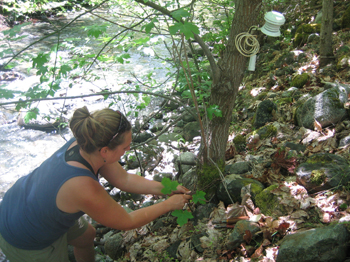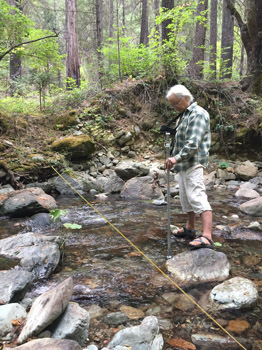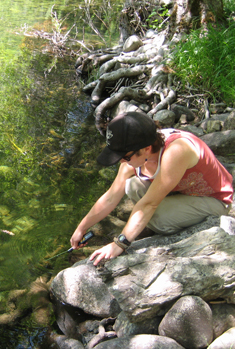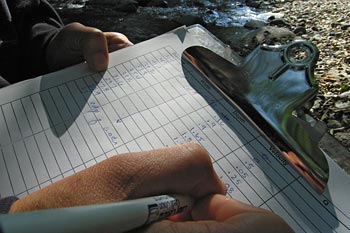Salmon River Restoration Council
- Overview
- Temperature
- Flows
- TMDL
- Program Contact
Overview
The SRRC and its cooperators have been monitoring water quality on the Salmon River since 1992.
Our monitoring program establishes baseline water quality data, supports the Clean Water Act's TMDL process, correlates river temperatures with fish behavior, characterizes fisheries refugia conditions, identifies opportunities for habitat improvement, assesses restoration effectiveness, and establishes community participation in the monitoring process.
Our monitoring program focuses on stream temperatures and stream flow, especially during the summer months when low flows and warm temperatures pose a threat to the health of the fishery. The Salmon River does not have an identified problem with chemical pollution.
The Salmon River is the most pristine tributary in the Lower Klamath watershed. It has natural, unregulated flow with no significant diversions and is an essential contributor of cold, clean water to the excessively warm Klamath River. Even so, the Salmon River periodically suffers from excessively high summer temperatures which can jeopardize anadromous fisheries. SRRC's water quality monitoring program plays an important role in the scientific assessment of overall river health and is contributing to the action plan of the Clean Water Act's Total Maximum Daily Load (TMDL) for the Salmon River.
Water quality in the Salmon River began to deteriorate from its natural conditions as a result of gold mining activity beginning in the 1850s. The river and streams were dammed, diverted and drained for mining activities, and massive amounts of sediment were discharged into the river. More recently, road building, commercial timber management, and large wildfires have negatively impacted water quality.
Temperature

Deploying air monitors to take temperature data
Temperature is one of the most important factors affecting the success of salmonids and other aquatic life.
Temperature influences growth and feeding rates, metabolism, development of embryos and alevins, timing of life history events such as upstream migration, spawning, freshwater rearing, and seaward migration, and the availability of food. Temperature changes can also cause fish stress and death.
The SRRC has been monitoring water temperatures on the Salmon River for more than 10 years. Community members became concerned about high water temperatures and began collecting data with hand held thermometers in the early 1990s. Since then the program has expanded dramatically and a number of different cooperators now participate in data collection including the SRRC, US Forest Service, students from the two local schools, community volunteers, and the Karuk Tribe.
Data is collected with automated digital temperature sensors--known as "Hobo Temps"--which are anchored in flowing water in a shaded area. Hobo Temp devices are placed at approximately 50 sites around the watershed and monitored between May and October each year. Air temperature is also monitored in several sites.
Flows

Measuring stream flow in North Russian Creek
The volume of flow in a river or stream affects Salmonid migration and also directly affects water temperature. Baseline flows are often related to upslope conditions in the watershed, including timber management and fire events. Monitoring flows can shed light on the best way to manage upslope habitats, and thereby improve the health of the river and its fisheries.
Since 2001, the SRRC and the Karuk Tribe have been measuring stream flow at approximately 20 locations on the Salmon River. Flows are monitored monthly during the summer at strategic locations on the North Fork, South Fork and Mainstem Salmon. The program focuses on tributaries which contribute crucial cold water to the Salmon River during the low-water summer months.
The program is a cooperative effort undertaken by the SRRC and the Karuk Tribe.
Total Maximum Daily Load (TMDL)

Handheld water thermometerphoto by S.J. Hugdahl
As a result of excessive summertime stream temperatures, water bodies in the Salmon River watershed are considered to be temperature impaired and subject to regulation by Section 303(d) of the Clean Water Act.
A Total Maximum Daily Load (TMDL) for temperature has been developed in compliance with the Clean Water Act. In June 2005, the California North Coast Regional Water Quality Board adopted the Salmon River TMDL and Implementation Plan.
The objective of the Salmon River temperature TMDL is to provide estimates of how much thermal input the river can assimilate without causing a deterioration of water quality standards. It concluded that channel geometry, riparian vegetation conditions and stream flow can affect stream temperatures, and that increased riparian vegetation could reduce stream temperature. Historic changes in the composition and amount of riparian vegetation has reduced shading and altered stream temperatures from natural levels.
The TMDL Implementation Strategy relies on a Memorandum of Understanding (MOU) with Klamath National Forest. The MOU is consistent with the existing management plans for the Salmon River, including the Salmon River Sub-Basin Restoration Strategy and the Klamath National Forest Land and Resource Management Plan.
The SRRC monitors stream temperatures and stream flow and has been working to assess the floodplain and riparian conditions for a number of years with the intention of implementing large scale floodplain restoration in the future.
Program Contact
Lyra Cressey
acting Water Quality Monitoring Project Coordinator
Salmon River Restoration Council
PO Box 1089
25631 Sawyers Bar Road (shipping only)
Sawyers Bar, CA 96027
phone: 530-462-4665
fax: 530-462-4664


Salmon River Restoration Council
PO Box 1089 | Sawyers Bar, CA | 96027
Salmon River (California)
530-462-4665
![]()
